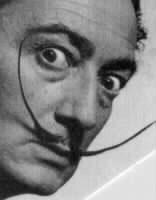Salvador Dali
Born: 1904-1989
  |
Salvador Felipe Jacinto Dali i Domenech was born on 11th May,
1904 in the small town of Figueres in Spain at the foothills of the Pyrenees.
As an adult he made his home with his wife, Gala, in nearby Port Lligat. He
died on January 23rd January 1989 in Figueres.
As a student, Dali
attended the San Fernando Academy of Fine Arts in Madrid. His first solo show
was held in Barcelona in 1925. He became recognised internationally when three
of his paintings were shown in the third annual Carnegie International
Exhibition in Pittsburg in 1928.
As the leader of
the Surrealist movement, his painting, The Persistance of Memory, with soft or
melting watches is still one of the best-known surrealist works.
Dali escaped from
Europe during World War 2, spending 1940-48 in the United States, which saw his
'classic' period emerging demonstrating a preoccupation with science and
religion.
During his artistic
career, Dali was a prolific printmaker, using many techniques including
drypoint, etching woodcut and lithography. With an output of at least 1700
prints. He is often commended as one of the finest graphic artists of the 20th
century.
In exploring the
printing medium, Dali often added his own idiosyncratic but innovative and
spontaneous graphic experiments. For example, he made tachiste plates -
irregular dabs or splotches of colour, by blasting them with explosive charges.
On other occasions he attacked the plates with an axe or bombarded them with
eggs containing lithographic ink. Some of his drypoints were produced with his
'dessin automatique' an automatic drawing technique where the artist believed
his hand movements were controlled by his subconscious mind.
Whatever the
technique the final result for his prints was always highly original and often
fantastic and colourful.